Solar Energy - lowers cost of luxury for Silver Coast property
Eco-House with solar energy and beach views on the Obidos Lagoon
An example of environmentally friendly home heating. Plus a case study for how the recent Portuguese legislation in support of solar energy has lowered the cost of luxury living in this four bedroom property on the Bom Sucesso beach. Image right shows front view of the courtyard and solar panels June 2009 - click any property images to enlarge
When the house was purchased by the current owner in 2005 it was neither warm nor energy efficient. The water heating was by gas. The cooking was by gas and electric, and the space heating in the winter was by solid fuel fireplaces and a wood burning stove. Lovely as a summer home but the heating was not ideal for winter use. Image below taken Christmas 2008 - Beach view from the living room window.

Initially the owner installed the pellet burners for space heating followed by the solar water heating, which instantly warmed the house and lowered the cost of hot water to an insignificant amount for the brief periods that the sun does not provide enough. Even those small costs are now covered by the photo-voltaic energy production.

The owner also contracted at the same time to install the photo-voltaic panels which, at the favourable rate paid to the owner for solar energy, will now produce more than enough revenue to pay all the utility bills, (gas, water and electricity) for the household and cover all (or most) of the cost of winter space heating.
As the implementation of legislation to allow selling the electricity to the national grid was delayed until 2008, the approval for the grid connection of the photo-voltaic system only took place in 2009 and the system was finally connected to the grid on 18th June 2009.
The photovoltaic panels were instantly providing and selling more than 14 kwh to the grid daily in June, although that figure is estimated to reduce substantially in the winter months. Nevertheless it is conservatively estimated that an average of 9kwh per day should be achieved by the system over a full year based on the national weather data.
The hot water system (solar thermic) provides the owner with all the hot water needed in both winter and summer.
For occasional short periods in the winter months, if inclement weather lasts for more than a couple of days, the hot water tank stores 390 litres of hot water which is sufficient to tide the owner over any cooler periods. Reversion to electricity or gas for water heating in such periods can be automatic, but the periods are so short that the owner opted to control this cost further by manually switching over to gas only if and when necessary.
Clean Pure and Plentiful Water.
Water is supplied to the house by both mains and bore hole. The owner has not needed to turn on the mains for more than a few hours during pump maintenance since purchasing the house. Water from the bore hole not only tastes nicer, and is filtered by activated charcoal for the house, but it is substantially cheaper than mains water.
The only water cost is the electricity to raise the water from below the ground, and the tiny standing charge on the idle mains water system. This means that water consumption for both garden and pool would not anyway be as costly as other properties in the region, but now in 2009 this cost is totally covered by the photo-voltaic energy production.
Pool heating.
The solar thermic system is pre-equipped with an automatic system to send the excess hot water energy to the swimming pool that the owner is planning on building. The solar thermic system produces far too much heat in the period March to November so the swimming pool season will certainly be lengthened. The plan is to either cover the pool with a purpose built retractable unit, or make the pool an indoor one. Either way with the probable addition of a heat exchange system the pool will be usable and much warmer all year round.
For space heating the owner has already installed 3 modern Ecoforest pellet burning stoves which provide push button heating where it is needed using fuel pellets made from forestry waste products. This makes the space heating both environmentally friendly, easy to use, and very economical.

The owner opted for three separate pellet burning units, two Eco-Aire and one Vigo from Ecoforest, rather than one large central one with radiators as this gives much easier and greater flexibility over where and when heat is produced and how it is distributed.

The log burning fireplaces have been retained in the property for character but as the heat from the pellet burners is more than enough the fireplaces are only ever used for cosmetic purposes. Typically a log or fir-cone fire is lit on special occasions like Christmas when a few flames in the hearth provide additional good cheer. The fir-cones are often collected from the roadsides in the empty pellet sacks while the owner is out walking which means that collecting the fuel for the fire also helps to provide good healthy exercise.
The cost of Energy Self Sufficiency.
In round figures the total capital cost of all the energy efficiency changes and additions detailed above was less than 30 thousand euros. As the revenue from the photo-voltaic panels should exceed 2 thousand euros per year, with space heating costs being around 700 for the pellets, and all the other utilities now reduced to around 1200, it is probable that the house will not only be energy self sufficient, but will show the owner a small and rising bonus.
With energy costs likely to rise in the longer term, and the amount paid by the grid contracted and legislated to rise proportionately, the capital investment should continue to be more than worthwhile. Image above taken Christmas 2008 - view on wintry day of choppy seas taken from living room window. Below the lagoon taken on a fine day over the same Christmas 2008 holiday period - click the images to enlarge.
All the above and a beach view can be yours if you wish. Just click on the link below to contact the owner for more details and see more of this:-
Eco-House with beach views on the Obidos Lagoon for sale.
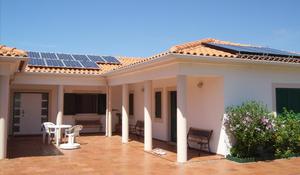

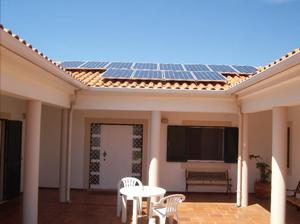

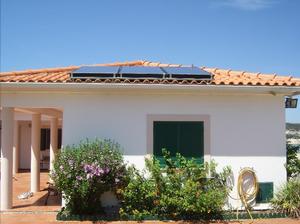
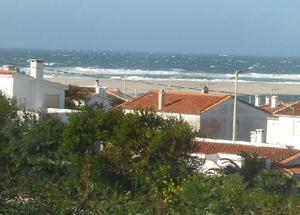
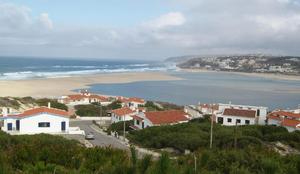
Comments
Hiya,
I have a few specific questions about your PV system which I
think is just about 12 months in to your contract.
Unless it's too private it would be very helpful to know: how
much did it actually cost, how many kw/h in the year do you
generate, how much did the EDP actually pay you in total during
the year, are there any running costs/annual maintenance to be
aware of?
Cheers,
Roberto
The above message posted by: Roberto do Lagoa | July 7, 2010 3:57 AM
Hello Roberto,
Before I answer your questions, I'll just point out that I chose
a smaller system than is cost effective. The area of roof we had
available was not big enough for the maximum allowed under the
EDP bonus scheme.
We've only got 12 panels, and a neighbour of ours has 24 (which
I can see from my bedroom window)
He bought from the same company after I recommended he look into
it. (I haven't yet asked him why so many, maybe they are not the
same type as mine?)
He had a much bigger south facing roof space available. To
squeeze the most out of a smaller roof space the cost of the
more efficient panels is slightly more. So he may have had the
cheaper panels.
Since the cost of the inverter (and installation) is the same
(about 5k) regardless of the size of the system, then it makes
sense to have as many panels as you can fit into your ideal
area, up to the maximum permitted for home production.
Our nominal output is 1900w - Maximum of 2200w
The most cost effective is, I believe, nearly double that
output. But certainly at least a nominal 3000w. (I think you are
allowed to produce around 3.6kw or 3.8kw under the bonus
scheme?)
Now on to your questions:-
>it would be very helpful to know: how much did it actually cost
We paid too much as we were early in to the system, and with
more competition in the market the prices are quite a bit
cheaper now. We paid 21k and I know our neighbour was quoted for
a 50% larger system for a little less.
On the plus side we are getting 65 cents a unit for the
electricity we sell to the EDP, whereas as a later arrival I
believe he is only getting 63 cents (or less).
The bonus being offered is being reduced gradually for later
entries - presumably to encourage people to get in before the
bonus disappears altogether. (which we understand it will as
there is a maximum ration before the EDP are allowed to withdraw
the bonus)
>how many kw/h in the year
My meter reading at nearly 50 weeks was 3080 kwh. (almost
precisely the 9kwh per day I estimated)
And if I had bothered to wash the panels in the dusty months,
I've no doubt it would have been a little more.
>how much did EDP actually pay you in total during the year.
Total for first 50 weeks or so was 1950 Euros (detailed below in
full - this is a much better return than bank interest and only
50 euros short of my estimate of 2000 euros - despite a pretty
bad winter)
The meter reading is sent in by GSM (automatic smart meter
connected to mobile phone mast) on 8th of every month, and the
funds are credited to our bank account 2 weeks later on or
around the 24th of every month.
They deduct our electricity consumption bill from the production
and pay us the difference.
As you only need the production figures, those are the ones I've
given here with amounts quoted being in Euros (EUR).
24/07/09 170.30 (payment for first 2 and a bit weeks in June 09)
24/08/09 254.15 (first full month / 8 July to 8 August 09)
24/09/09 215.80
24/10/09 172.25
24/11/09 137.80
24/12/09 81.25 (hurricanes etc and phone lines down)
24/01/10 81.25 (strange coincidence - did they estimate?)
18/02/10 94.90 (change of payment dates?)
18/03/10 96.20 (we now seem to be getting paid earlier?)
13/04/10 194.35 (and earlier)
12/05/10 208.00 (and earlier)
19/06/10 243.75 (almost back to the usual date)
Total first year = 1950 EUR (being less than 52 weeks - I
think this covers about 355 days)
It's quite odd that if we had been talking a full year with ten
more days we would have exceeded the 2000 EUR I originally
estimated, but only by a few Euros.
My estimate was done by looking up the hours of sunshine
statistics for our area on the Portuguese met office. I divided
the first few weeks production by their average for those weeks,
and then multiplied that figure by the average for the year. The
fact that the figure should be so precisely accurate is
encouraging and comforting - but still strange.
>are there any running costs/annual maintenance
None that we've encountered thus far. We had to call them out in
the spring when the inverter was reporting a start up error, and
was delaying starting up by 30 minutes or so. Turned out to be
two wires too close together in the fuse box and humidity making
a potential short possible, which the inverter somehow managed
to detect and was dutifully reporting before starting production
anyway.
We've not been billed for any service visits thus far.
We were told we could wash the dust off panels, but we've been
lazy and let the rain do it. (there has been quite a bit of rain
this last winter and spring - although the weather at the moment
is making me think I should get the hosepipe out and wash the
dust off)
We've added the panels to our home insurance, but we haven't had
the revised premium for this year yet.
I can ask my contact to send you a quotation at today's prices
if you like. I'm sure there is no pressure as they are so snowed
under with work they only tend to send anyone out when they are
pestered to do so.
I asked them to contact my sister about six months or more ago,
and I don't think she's heard from them after getting the basic
literature. We didn't pester them about her enquiry, as she was
only mildly interested anyway.
regards,
David
Silver Coast Property blog at:-
http://rainha.com/property/
The above message posted by: David | July 8, 2010 2:07 AM
Hello David
Many thanks for the very helpful response.
You must be pleased with how it's worked out so far, and very
reassuring when it turns out pretty much the way it was supposed
to. I'm probably a bit too cautious to be any good as an early
adopter of anything, but with real euros flowing into your bank
and at the same time making a genuine contribution towards
improving the environment must be very rewarding all round for
you.
I've only spoken briefly to a couple of companies claiming who
sell this "solution" but I haven't yet gone into more detail
with any of them yet. I'm in the camp where whatever looks too
good to be true always is.
There seems to be a standard package costing around 20 - 25k
euros for a typical 5-6kWh/year system with a payback in 6-8
years (but see below), or at least that's the only thing they
wanted to talk about. For this they talk about a tariff of 0.615
euro/kwh and an annual income of up to 4k euros pa. This does
sound in proportion to your "actuals" which as you point out are
based on a smaller system.
The cost also now includes the installation of 2 solar thermal
panels which are compulsory if you haven't got any yet.
From my perspective, although I am looking to renovate my house
in as green-friendly a way as possible I will (can) only do it
where it makes financial sense for me. Companies talk loosely
about using all this free electricity and of reducing your
energy bills to practically zero and hope we don't ask difficult
questions like how much does all this free stuff really cost me.
Bearing a small premium is one thing but that's rarely the case.
I first thought of solar PV as a means of reducing my need to
buy electricity which over time will get more and more
expensive. I want to put in some heating and cooling and at the
same time I wanted to move away from Propane based HW system and
cooking which is currently only costing around 500 euros pa but
rising. By going all-electric and using PV to generate as much
as possible seemed to make sense. But then reality takes over,
as well as all the costs of this you need to set aside a few
acres for panels/batteries etc. And then of course there's
winter when you're back to using electricity again anyway.
If I was off the grid then maybe the sums would be different but
the EDP solution is actually a neater proposition for me by
effectively turning it into a straight financial decision - is
investing 25k euros to create an income by generating green
electricity competitive with other investments such as say a
long term fixed rate savings account. The last time I looked
these paid upwards of 4% gross. Or using ISA's and investing £5k
in each of the next 5 years you could get around 4.5% after tax.
In both cases the income goes towards paying the same edp bill
(or better still, use some of this this income to pay for
insulation which can (substantially in England at least) reduce
energy consumption and your carbon footprint as well as your
outgoings in a nice little virtuous circle.
Over here people look at me as though I've clearly lost it
whenever I ask about insulation.
From your figures an investment of 21k is giving you a gross
return of nearly 2000 euros (I'm assuming this is gross before
edp take off your monthly charges), or 9.5% in round numbers.
This is clearly really good compared to interest on bank
savings. However, it's only at that level for a while and then
drops off (towards zero?).
Also, at the end of the contract the investment probably has
zero value, unlike say savings. Or it could be negative if you
actually have to pay people to take it away.
So, to help me work out what my real returns would be I think
I'd need to know:
a) are the edp payments you get completely free of tax, or do
they count as income or something?
b) contract length and guaranteed payment schedule. I've heard
it's a 15 year deal with the 65 cents only guaranteed for the
first 5 years. What tariffs have EDP committed contractually to
you and for how long - do you have such a schedule?
c) What happens at the end of the contract if the system is
still working? Will EDP just keep buying electricity from you?
Is any of this in your contract?
It would be great if you had any of this to hand but I would
like to talk in more detail to your friendly contact anyway and
get a proper quote. I'd probably also want some re-assurances
from him about:
d) Although there won't be many moving parts the system will
have to endure incredibly high temperatures virtually
indefinitely. What are the warranties on all the important bits?
What, realistically is the life expectancy and is there evidence
to show this?
e) Termination. Can EDP just end the contract when they want, or
after the minimum period, or what? My limited experience dealing
with utilities/local authorities in the UK is that you contract
with them on their T&C's which they own and can change or stop
at will whether you like it or not - all they have to do is tell
you it's changed. (I assume you can stop selling electricity to
them whenever you want e.g if you wanted to sell your house).
f) Cost of disposal. What happens when it eventually dies and
there aren't any spares and you have to get rid of it? No-one
knows what it might cost in 15-25 years time, but what would it
cost today to decommission and take to somewhere appropriate for
safe disposal?
Thanks again for all your help. My reply has got far too long so
please feel free to save your time and just answer yes, no,
don't know, 55 pence, yes etc, and I'll get the rest from the
guys you bought the system from.
cheers,
Roberto do Lagoa
The above message posted by: Roberto do Lagoa | July 9, 2010 1:43 PM
Hello Roberto,
you wrote:
>I'm probably a bit too cautious to be any good as an early
>adopter of anything
I'm also a cautious person, but I have been trying to find a way
to generate electricity myself by wind and/or solar for more
than twenty years. I'd like to have the benefit of energy
security too, but like you I found the idea of expensive banks
of batteries with a very limited life to be ludicrous.
My original hypothesis twenty years ago was that I would only
want a limited couple of hours of battery back up, enough to
smooth out wind production, and give enough time to turn off all
non essential usage and start up a small diesel or petrol
generator.
When I first enquired of the only supplier in Portugal in the
late eighties, at the time I was told that for now I could only
produce for my own use, but that they hoped for a law very soon
to allow us to sell our excess into the grid.
It took more than twenty years after my first enquiry for the
law to be put on the books and actually put into practice for
more than a select few as a trial (which I somehow missed the
boat on). And when the full law came it was better than I had
hoped for.
I'd already decided that with energy prices rising at least as
much as inflation, that an investment in electricity production
using wind turbines would be profitable in the long term even if
we got paid a touch under the current market price for
production. (which was all we were expecting in 1990's)
I certainly didn't expect such an attractive bonus rate to be
paid for solar PV which would make the decision to invest so
much easier. I'd still like to buy a wind turbine as well, or
extend our solar production, and will probably do one or both
when I find the time to investigate the possibilities further.
>You must be pleased with how it's worked out so far
My only disappointment so far is that I didn't go for the
maximum, which as I've just looked up the law, was I believe,
still 5.65kw. (but that may change now - see below)
When I made the commitment, the law still had not been
finalised, so I was cautious about the size of the system I
would invest in. We were in the queue to get in for a couple of
years prior to our installation being supplied and connected to
the grid.
Had I have known when I made the commitment how simple it was
actually going to be to get paid for electricity, I would have
built a pool house (to cover our future covered pool) with a
suitable roof space to take around 2 dozen panels.
To be fair, the company assured me of the details of the law
which was going to be enacted as they were well connected and
part of and party to the discussions with the government, but I
was doubtful of it ever going into effect, having been waiting
for so long for the government to get their finger out.
They had given me an outline of a system paying me 0.5656 (just
over 56 and a half cents) per unit, and when the law was finally
enacted the rate was even better at 65 cents.
I'm sending you the file covering the law and regulations in
Portugal - "DECRETO-LEI n.º 363/2007 de 2 de Novembro" by
private email, but others can download it via the link here on
the blog.
You can also get an automated English translation of this
document from Google at:-
http://tinyurl.com/34u6ssv
>I'm in the camp where whatever looks too good to be true
>always is.
That is sage advice that I often give to others in regard to
offers they receive from "Nigeria", or emails telling them
they've won a lottery, et al :-) But when you drill down into
the maths, this isn't actually "too good to be true" it is
incentivised to be just good enough to ensure that PV micro-
production is financially reasonably good sense.
To roughly quote Donald Rumsfeld there are "known knowns, known
unknowns and unknown unknowns" which have to be taken into
account.
With a long history going back to the early alternative energy
projects in Wales and elsewhere, most folk know that wind power
is a dead cert to be financially rewarding over the long term.
(even at basic production rates). With the incentives now
available even the banks like the investment. Witness the
turbines going up everywhere in the world.
But long term rewards from solar were always less certain. The
bonus given is just sufficient to get the ball rolling, and
deliberately tailored to reduce until they find the point at
which the consumer would say it's not attractive enough.
The theory is that with everyone else doing it, and with some
history behind it, in ten years time folk will commit with a
much smaller bonus. And they will find the right price point
using early adopters to do so. It's a clever compromise that
works for both sides of the equation.
>There seems to be a standard package costing around 20 - 25k
>euros for a typical 5-6kWh/year system with a payback in 6-8
>years (but see below), or at least that's the only thing they
>wanted to talk about.
When I talked to my supplier about producing electricity for
myself and selling just my excess, he rightly asked me "why
would you want to do that?"
Why would I want to keep my own electricity and save myself only
11 cents a unit on inputs, instead of supplying outputs to the
grid at nearly 57 cents per unit. (the figures at the time).
So, that's why they don't want to talk about the more
complicated arrangements of batteries to cut yourself off from
the grid, et cetera. It's just not financially sensible when
compared with the deal offered for PV. (wind power is another
matter)
I got my supplier to quote me for the full battery system
anyway, but it was obviously madness not to accept the bonus on
offer.
>For this they talk about a tariff of 0.615 euro/kwh and an
>annual income of up to 4k euros pa. This does sound in
>proportion to your "actuals" which as you point out are based
>on a smaller system.
Until 1st June 2010 (see below) it was all laid down in the law
"DECRETO-LEI n.º 363/2007 de 2 de Novembro" - the rate for the
first ten megawatts from micro-producers started at 65 cents per
unit. Thereafter for each ten megawatt tranch of new suppliers
to the grid, the rate was going down by 5%.
The .615 means that it has already gone down by the first 5% and
that is/was a real incentive to commit. But today I see on the
quasi-government (quango) web site where you would register as a
micro-producer at:-
renovaveisnahora.pt
that as of June 1st this year, new sign-ups are on hold. I
translate and quote:-
"suspended acceptance of new pre-registrations since the day
June 1, 2010 22:00 (Continental time) until the entry into force
of new legislation"
So I think that if you applied now you would find that you will
only get in at around .585 (or less?) when the government budget
restrictions ease up a bit.
But, if I were you I would do the same that I did. Have them
supply the thermal (hot water) system, and agree a deal on the
PV to be enacted the moment they get the new legislation. You
want to be in the queue when it all starts again.
>The cost also now includes the installation of 2 solar thermal
>panels which are compulsory if you haven't got any yet.
Yes indeed, and any alterations or modifications to a property
over a small figure (I think it's about 10k) now require the
installation of solar panels for hot water anyway. As do all new
builds.
>From my perspective, although I am looking to renovate my
>house in as green-friendly a way as possible I will (can) only
>do it where it makes financial sense for me
Well if your renovation costs more than the amount the law
states, you'll have no choice but to install solar thermal (hot
water).
I can say from experience that the hot water is well worthwhile.
We cook by electric oven and gas hob, and our hot water was by
gas "esquentadores". Prior to getting the solar thermal we were
buying one or sometimes two of those big torpedoes of gas every
six weeks on average. I now honestly can't remember the last
time we bought one. It was certainly during the winter, and must
be well over six months ago.
We are definitely down to less than 3 big bottles a year. I'd
estimate a saving there of well over six cylinders a year. Which
at current rates is a lot more than 400 euros saved, and the
price/saving is rising all the time.
>Companies talk loosely about using all this free electricity
>and of reducing your energy bills to practically zero and hope
>we don't ask difficult questions like how much does all this
>free stuff really cost me. Bearing a small premium is one thing
>but that's rarely the case
Well our household energy and water bills are now less than zero
on a smaller than efficient solar production system.
Our total nett receipts from the EDP are 1101.23 for the first
50 weeks (being the amount they paid us after deducting our
electricity bills)
Our water is also included in that figure as we pump our water,
using electricity in the above figure, from a bore hole. We do
pay 37.80 per year in standing charges for a mains water supply
which we hardly ever use. (we've used less than two euros per
year of water on average during bore hole pump maintenance)
Our gas is now around 200 Euros per year (or less).
Deduct all that and that still leaves us with at least 860 Euros
to pay for pellets for our solid fuel heating system which you
can see pictures of here on the blog:-
tinyurl.com/les4k3
Pellets usually cost us about 700 per year.
So we are nett energy/utility producers to the tune of
approximately 160 Euros.
Sadly that's not quite enough to cover our broadband by ADSL -
which is one modern day utility. But it was enough to pay for a
cheap chinese petrol generator this year which produces enough
to run our freezer, a few lights, the pellet burners, and our TV
during power cuts. So we've even got some energy security now.
We also light our open fire at Christmas, not for heat, but just
because we like to. But we only burn scrap timber and fir-cones
we collect from nearby woods. We've always got far more free
wood available than we'll ever be likely to use.
>I first thought of solar PV as a means of reducing my need to
>buy electricity which over time will get more and more
>expensive
Yes, so did I, but it's better to sell all your production to
the grid at say 58 cents and buy back what you need at say 13
cents. (approximate current figures)
>I wanted to move away from Propane based HW system and cooking
>which is currently only costing around 500 euros pa but rising
You can easily cut that in half using a solar hot water system.
>reality takes over, as well as all the costs of this you need
>to set aside a few acres for panels/batteries etc.
Well, a small shed would have been the case, but as you
identified later in your post, no batteries are needed now as
you'll sell all your production to the grid.
>then of course there's winter when you're back to using
>electricity again anyway.
Not any more, in effect, if you sell all your production to the
grid. Here are my winter/summer figures for the last nearly 12
months (50 weeks) starting June 2009:-
production consumption nett running total received
170.30 EUR 64.92 EUR 105.38 EUR
254.15 EUR 70.67 EUR 288.86 EUR
215.80 EUR 68.38 EUR 436.28 EUR
172.25 EUR 59.09 EUR 549.44 EUR
137.80 EUR 64.46 EUR 622.78 EUR
81.25 EUR 77.15 EUR 626.88 EUR
81.25 EUR 83.34 EUR 624.79 EUR
94.90 EUR 75.43 EUR 644.26 EUR
96.20 EUR 49.39 EUR 691.07 EUR
194.35 EUR 81.21 EUR 804.21 EUR
208.00 EUR 89.32 EUR 922.89 EUR
243.75 EUR 65.41 EUR 1101.23 EUR
As you can see, only in December was there a nett outgoing to
the EDP of just over 2 Euros. So the system even generates
enough to stop the electricity bills in the depths of winter.
In our case the solar pv is also covering quite heavy garden
watering which our neighbours are complaining costs them a
fortune in water bills.
>the EDP solution is actually a neater proposition for me
Yes. That's the reason they set it up that way.
>effectively turning it into a straight financial decision - is
>investing 25k euros to create an income by generating green
>electricity competitive with other investments such as say a
>long term fixed rate savings account. The last time I looked
>these paid upwards of 4% gross. Or using ISA's and investing £5k
>in each of the next 5 years you could get around 4.5% after tax.
Being resident in Portugal for tax purposes I don't think I have
access to the same UK investment accounts as you. If I did, I'd
probably say that those figures are roughly comparable with the
likely real returns on solar over the long term, given that
there must be some long term downsides as you discuss later.
I think the solar pv has the edge in that it has greater potential,
but for that there is possibly a slightly greater risk.
However, you should take into account the real possibilities of
a financial institution failing (banks may fail).
In my case I like the idea of having at least some of my bank
account on the roof where I can see it. (safe as houses?)
You may also be ignoring the IRS incentives of paying you 30% of
your installation costs up to a maximum of 777 euros.
See:-
renovaveisnahora.pt/web/srm/28#P16
But why does it have to be an either/or situation? Invest in a
larger solar pv system and then plough the 4k to 5k a year you
will save into the ISA - then you get both for the same
investment. Would that qualify as laughing all the way to the
bank?
>Over here people look at me as though I've clearly lost it
>whenever I ask about insulation.
Our house already has double glazing, roof insulation and wall
insulation but we could probably invest some more in that too.
>From your figures an investment of 21k is giving you a gross
>return of nearly 2000 euros (I'm assuming this is gross before
>edp take off your monthly charges),
Yes. The nett figures after electricity consumption are above.
>or 9.5% in round numbers. This is clearly really good compared
>to interest on bank savings. However, it's only at that level
>for a while and then drops off (towards zero?).
Not zero. Drops towards the rate that electricity will cost in
the future.
If you invest in a larger system, then I'm certain you can
improve on my return and get that figure up to over 10% - and on
a 5.65kw system that is going to be well over 12% in practice if
they re-introduce the same bonus scheme.
My reading of the law I've sent you says that the return was
guaranteed for five years. Then for the following ten years you
were guaranteed to get the rate that is available for new
entries to the system.
While that may now change for new entries, I'm pretty certain
that they will not succeed in making any retrospective changes
to the deal we signed up for. Even if they wanted to, I can't
imagine the supreme court here would let them get away with it.
I'm guessing the amount payable for new entries in four years
time will still be more than the amount we are paying for our
electricity then. (or at worst around the same figure) And given
the ever increasing price of energy, that amount will be worth
having. It may even approach current bonus rates in ten years
time?
>Also, at the end of the contract the investment probably has
>zero value, unlike say savings. Or it could be negative if you
>actually have to pay people to take it away.
I'm not anticipating a negative value happening. The original
quotation and investment illustration I received for the PV
solar estimated 1% of the electricity production being used for
maintenance from year 11 onwards. How accurate that is I've no
idea.
But assuming a worst case of complete failure of some parts of
the equipment then I'm sure that there will be a recycling value
of anything that ceases to be in working order. Just like mobile
phones there's a lot of money in the copper in an inverter, and
the precious metals in solar cells.
I'm planning on replacing anything that is not working and
continuing to produce electricity.
Savings in financial institutions are not always 100% secure,
although many of them are of course guaranteed by governments up
to a certain figure. At the end of 15 years the actual value in
real terms of your cash is going to be substantially less than
it was at the start. (especially now that they are printing
money - aka quantitative easing)
So, in reality it's measuring one set of bank or government
promises and guarantees against another. I'm not confident
enough in banks to commit my money to them for five years, and I
am confident that my pv system will be adaptable and worth at
least as much as the amount it has not yet repaid me on my
investment.
>a) are the edp payments you get completely free of tax, or do
>they count as income or something?
The Portuguese law states that income from micro production up
to 5k a year is exempted from income tax.
(Your own tax position may be different if you have opted to be
tax resident in the UK - you would need to check that with your
accountant or your tax office)
See:-
renovaveisnahora.pt/web/srm/28#P16
>b) contract length and guaranteed payment schedule. I've heard
>it's a 15 year deal with the 65 cents only guaranteed for the
>first 5 years. What tariffs have EDP committed contractually
>to you and for how long - do you have such a schedule?
The EDP contract simply refers to paying in accordance with
"DECRETO-LEI n.º 363/2007 de 2 de Novembro"
My reading of that law is that the return is guaranteed for five
years. Then for the following ten years you are guaranteed to
get the rate that is available for new entries to the system at
that time. (have your own solicitor advise you if you are in
doubt)
>c) What happens at the end of the contract if the system is
>still working? Will EDP just keep buying electricity from you?
>Is any of this in your contract?
Yes. The contract states that it is for an indefinite period. I
read that to say open ended and that it can only be terminated
in ways defined by the law. There are reasonable grounds like
abuse stated in the contract.
I'd anticipate future laws will define how much must be paid for
micro-production. I see no reason why a Portuguese government
who have made and followed through on such a firm commitment to
solar and wind production since Kyoto would have a change of
heart in the future.
But if they did, then I'd buy some new generation batteries in 5
or 10 years time and use the equipment to reduce my energy
bills. I'd also buy a wind turbine at that time if I hadn't
already.
>It would be great if you had any of this to hand but I would
>like to talk in more detail to your friendly contact anyway and
>get a proper quote
I've asked the company that I purchased from to contact you.
>I'd probably also want some re-assurances from him about: d)
>Although there won't be many moving parts the system will have
>to endure incredibly high temperatures virtually indefinitely.
There are of course massive solar farms all over the world now,
all enduring the same stresses. More and bigger ones are being
built daily.
See:-
wikipedia.org/wiki/Solar_farm
I doubt that such hard headed business people would be investing
large sums of money into the above projects if the technology
couldn't stand a bit of heat.
>What are the warranties on all the important bits? What,
>realistically is the life expectancy and is there evidence to
>show this?
I've asked my contact to answer this question, as I can't tell
you what the current offer is.
My own quotation offered a 6 year guarantee on hot water panels,
and a 5 year guarantee on pv panels and inverter. That covers
the highest cost items. Other equipment, and there isn't much of
that, presumably hot water tank, pipes and valves, 2 years.
There were better guarantees on offer (ten years) elsewhere on
solar thermal when I purchased, but I liked the equipment I went
with much more for various reasons. I particular liked the flat
profile on the roof and the large storage tank being at ground
level.
My quotation and investment forecast projected income from the
system going out to 25 years. (I doubt the actual panel models
in use today are the same as any first used 25 years ago, so
it's probably a reasonable guess based on lab testing).
However my own quotation guaranteed 90% of nominal production
for the first 12 years, and 80% of nominal production for the 25
years estimated life of the installation.
After somewhere between 5 and 25 years I'm certainly prepared to
replace panels with newer, cheaper and better technology if
needs be. Long before that time I'd be looking to increase the
size of the solar pv system anyway.
>e) Termination. Can EDP just end the contract when they want,
>or after the minimum period, or what?
They can only terminate it in the ways defined by the law and
the abuse items mentioned in the contract. They all looked quite
reasonable to me and my solicitor.
>My limited experience dealing with utilities/local authorities
>in the UK is that you contract with them on their T&C's which
>they own and can change or stop at will whether you like it or
>not
The law looks quite well considered on this to me. Also the EDP
will presumably have to meet it's own legally defined minimum
targets for purchasing PV and Wind. So they may need us as much
as we need them.
The law in Portugal is also liberalising the supply, so I'd
anticipate some competition from the Spanish in the future.
There is no doubt in my mind that the government here dragged
their feet on letting micro-production in to the system for many
years while the EDP and Cenel were one big state owned monopoly
and it suited them to lock us producers out.
But once the separation of EDP and Cenel, then the
liberalisation and privatisation demanded by the EU happened,
they then realised they could give the national EDP and Cenel a
competitive basis, by requiring foreign producers to meet
Portuguese alternative energy targets.
(a cynic might say that's a bit like the UK 3 pin plug and kite
marks being standards originally invented to give UK
manufacturers an edge over Europe)
Since then the EDP has become a world leader in alternative
energy, owning solar and wind plants in other parts of the
world, not least in France and the USA. Their solar/wind
division is a business success story.
>all they have to do is tell you it's changed. (I assume you can
>stop selling electricity to them whenever you want e.g if you
>wanted to sell your house).
My reading of the contract is that we can transfer it to new
owners of the house. The law also seems to state that we can
also choose to keep the contract and move the equipment with us
to a new property subject to the same inspection process.
>f) Cost of disposal. What happens when it eventually dies and
>there aren't any spares and you have to get rid of it?
Why would that ever happen? All the parts are separate modular
components and will be replaceable by newer. (probably cheaper),
and often better technology. It's just 12, 18 or 24 solar
panels, some wires, and an inverter. The government quango even
gives a list of approved equipment on:-
renovaveisnahora.pt/web/srm/consulta
>No-one knows what it might cost in 15-25 years time, but what
>would it cost today to decommission and take to somewhere
>appropriate for safe disposal?
Hardly looks like a costly exercise to me. I could fit the whole
lot in a box that came on one pallet when it was delivered. I
could unbolt the panels and inverter in an afternoon.
There is sure to be a recycling value which would stop me just
dumping it. (people will already pay you for such stuff!)
Also, the panels and inverter would easily fit into the boot (or
back seat) of my car and could simply be dropped into the
appropriate electrical goods recycling bin outside the local Le
Clerc supermarket in Caldas.
Our local Obidos council are begging for folk to dump electrical
cables on them for charity because they have such a large
recycling value.
But even if I no longer had a car, I could put it all out by the
bins and just call the council and have them take it away at
little or no cost. That's how it works here for white goods, or
anything too big for the bin.
I do hope the above is helpful.
Warm regards,
David
Silver Coast Property at:-
http://rainha.com/property/
The above message posted by: David | July 12, 2010 3:43 AM